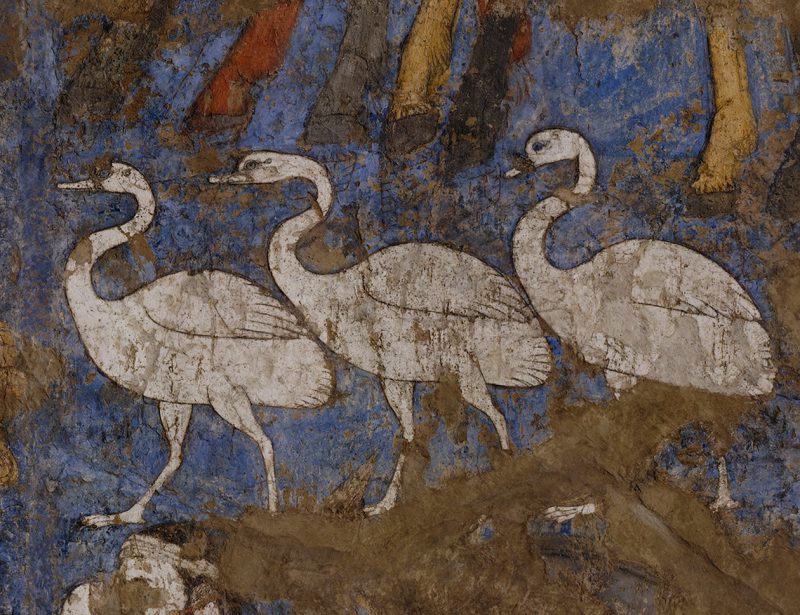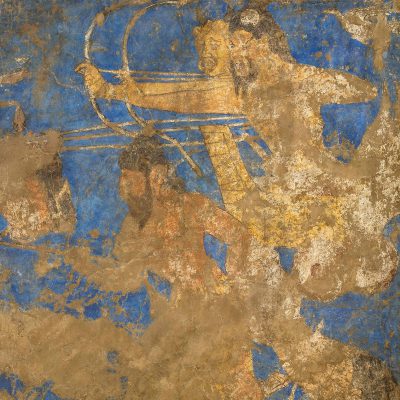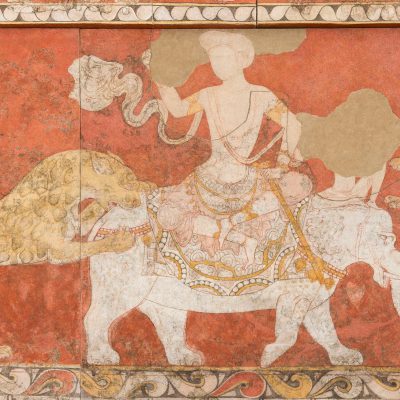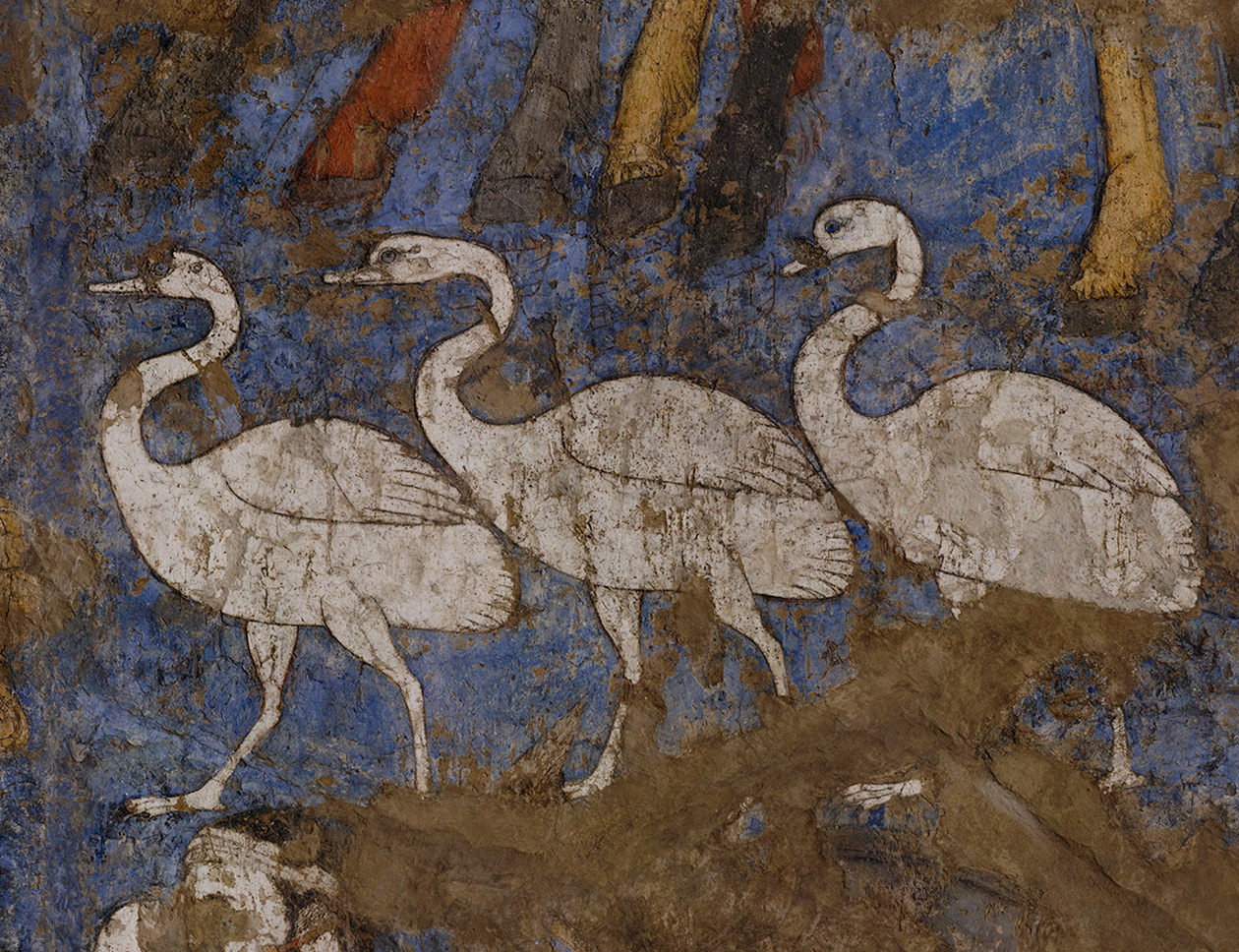
Afrasiab mural paintings
“Hall of the Ambassadors”
Afrasiab (present-day Samarkand), Uzbekistan (in ancient Sogdiana) , Site XXIII:1, mid-7th century CE
Wall painting; H. 3.4 × W. 11.52 m
Afrasiab Museum.
Photograph by Thorsten Greve © Association pour la sauvegarde de la peinture d’Afrasiab, and Freer Gallery of Art and Arthur M. Sackler Gallery, Smithsonian Institution.
Excavated in the 1960s, the wall paintings of the ancient city of Afrasiab (near modern-day Samarkand in Uzbekistan) present an unparalleled example of Sogdian art. The level of detail and skill in the portrayal of these complex tableaux continues to fascinate scholars, but the paintings remain only partially understood due to several missing parts. The scenes are arranged on the four interior walls of the reception hall of an aristocratic residence. The western wall depicts a long procession of people of different origins, including a large number of Turks escorting delegations from China, the small Central Asian states of Chaghaniyan and Chach —even from Tibet and the Korean kingdom of Goguryeo ; Fig. 1.

Fig. 1 Click to enlarge and scroll through the West wall of the Hall of the Ambassadors. Afrasiab (present-day Samarkand), Uzbekistan (ancient Sogdiana), Site XXIII:1, mid-7th century. Wall painting; H. 3.4 m × W. 11.52 m. Afrasiab Museum.
Photograph by Thorsten Greve © Association pour la Sauvegarde de la Peinture d’Afrasiab and Freer Gallery of Art and Arthur M. Sackler Gallery, Smithsonian Institution.
These diverse people, some bearing gifts, appear to converge toward the top of the composition, which is unfortunately now lost. An inscription mentioning King Varkhuman receiving envoys at Samarkand provides a clue as to who might have been portrayed receiving these gifts, but this identification is debated. While scholars agree that the four walls were conceived as a coherent program, its nature remains open to speculation.
The other three walls offer detailed compositions of varied subject matter. The south wall is dedicated to Samarkand itself and to the cult of its royal ancestors. It shows a procession of richly dressed courtiers with a more-than-life-size figure of Varkhuman himself on horseback. His wives ride in front of him, with sacrificial animals behind: a riderless horse and, following priestly figures, four geese; Fig. 2.

Fig. 2 Click to enlarge and scroll through the South wall of the Hall of the Ambassadors. Afrasiab (present-day Samarkand), Uzbekistan (ancient Sogdiana), Site XXIII:1, mid-7th century. Wall painting; H. 3.4 m × W. 11.52 m. Afrasiab Museum.
Photograph by Thorsten Greve. © Association pour la Sauvegarde de la Peinture d’Afrasiab and Freer Gallery of Art and Arthur M. Sackler Gallery, Smithsonian Institution.
This probably represents the Nowruz (New Year) celebration, which involved animal sacrifice. A closer look at the geese shows the use of stencils to paint repeated elements, a technique also used for horses and figures’ hands; Fig. 3. By contrast, people in Chinese attire occupy the entire north wall. They comprise a group of riders hunting wild cats, and a pleasure boat carrying Chinese ladies, most likely the Chinese empress and her retinue; Fig. 4. The east wall is the most deteriorated, but we can discern figures sporting Indian garb and hairstyles; Fig. 5 and 6.

Fig. 4 Click to enlarge and scroll through the North wall of the Hall of the Ambassadors, showing a group of figures in Chinese dress (left), and a hunting party (right). Afrasiab (present-day Samarkand), Uzbekistan (ancient Sogdiana), Site XXIII:1, mid-7th century. Wall painting; H. 3.4 m × W. 11.52 m. Afrasiab Museum.
Photograph by Thorsten Greve © Association pour la Sauvegarde de la Peinture d’Afrasiab and Freer Gallery of Art and Arthur M. Sackler Gallery, Smithsonian Institution, Washington, D.C.

Fig. 5 Northern portion of east wall of the Hall of the Ambassadors, showing fragmentary figures in Indian attire. Afrasiab (present-day Samarkand), Uzbekistan (ancient Sogdiana), site XXIII:1, mid-7th century. Wall painting; H. 3.4 m × W. 11.52 m. Afrasiab Museum.
Photograph by Thorsten Greve © Association pour la Sauvegarde de la Peinture d’Afrasiab and Freer Gallery of Art and Arthur M. Sackler Gallery, Smithsonian Institution.
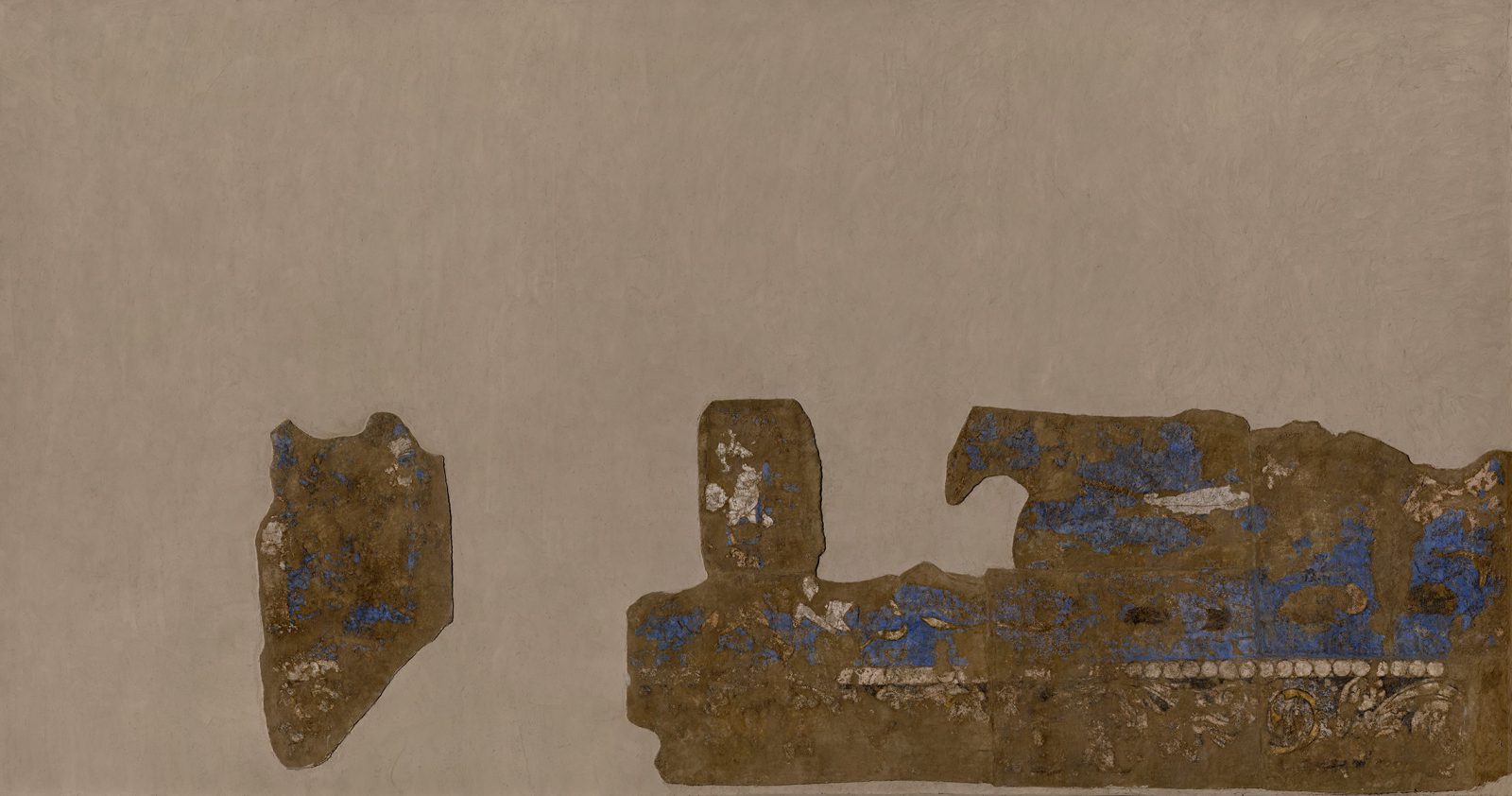
Fig. 6 Southern portion of east wall of the Hall of the Ambassadors, showing fragmentary figures in Indian attire. Afrasiab (present-day Samarkand), Uzbekistan (ancient Sogdiana), site XXIII:1, mid-7th century. Wall painting; H. 3.4 m × W. 11.52 m. Afrasiab Museum.
Photograph by Thorsten Greve © Association pour la Sauvegarde de la Peinture d’Afrasiab and Freer Gallery of Art and Arthur M. Sackler Gallery, Smithsonian Institution.
Scholars debate the identity of many of the figures on the walls, but none more than what once occupied the top and center of the western wall. This is the focus of the converging delegations and is emphasized by the projection of the sufa, the built-in bench of plaster-covered clay at the center of this wall. Very likely it depicted the most important figure(s), and several scholars have proposed various possibilities. It might have been Varkhuman himself receiving visitors (the idea of Frantz Grenet); Varkhuman partaking in the Nowruz Festival (Matteo Compareti); Varkhuman’s coronation in conjunction with the Nowruz Festival (Chiara Silvi Antonini); or Varkhuman accompanied by the leader of the Western Turks under the auspices of the gods (Markus Mode). It could also have been a seated deity—quite possibly Nana—or a pair of divinities (Boris I. Marshak). Without the missing part, all are but educated guesses. Nonetheless, what is clear is that the pictorial program was meant to represent the reach and power of the ruler of the most important Sogdian city-state—ironically, on the eve of the Arab incursions into Sogdiana.
by Julie Bellemare and Judith A. Lerner
See Vladimir A. Livšic [Lifshits], “The Sogdian Wall Inscriptions on the Site of Afrasiab,” in Rivista degli studi orientali, n.s. 78, Supp. No. 1: Royal Naurūz in Samarkand: Proceedings of the Conference held in Venice on the Pre-Islamic Paintings at Afrasiab (2006): 59–74.
François Ory, “Essai de restitution des parties manquantes de la peinture d’Afrasiab,” in Royal Naurūz in Samarkand (2006), 88.
See Frantz Grenet, “What was the Afrasiab painting about?” in Royal Naurūz in Samarkand (2006), 43–58; Chiara Silvi Antonini, “The Paintings in the Palace of Afrasiab (Samarkand),” Rivista degli studi orientali 63 (1969); Matteo Compareti, “A Reading of the Royal Hunt at Afrāsyāb Based on Chinese Sources,” in Royal Naurūz in Samarkand (2006), 173–84; Markus Mode, “Reading the Afrasiab Murals: Some Comments on Reconstructions and Details,” in Royal Naurūz in Samarkand (2006), 107–28; and Boris Marshak, “Le programme iconographique des peintures de la ‘Salle des Ambassadeurs’ à Afrasiab (Samarkand),” Arts Asiatiques 49 (1994): 1–20, and “Remarks on the Murals of the Ambassadors Hall,” in Royal Naurūz in Samarkand (2006), 75–86.
See Northeast Asian History Foundation/Dongbug-a Yeogsa Jaedan 동북아 역사
재단, Apeulasiab hungjeon byeoghwa 아프로시압 궁전
벽화 [Afrasiab Palace Wall Painting]. Virtual Experience of Afrasiab Palace Mural. UNESCO World Heritage, Samarkand: Crossroads of Cultures. Online at http://contents.nahf.or.kr/goguryeo/afrosiab/english.html
